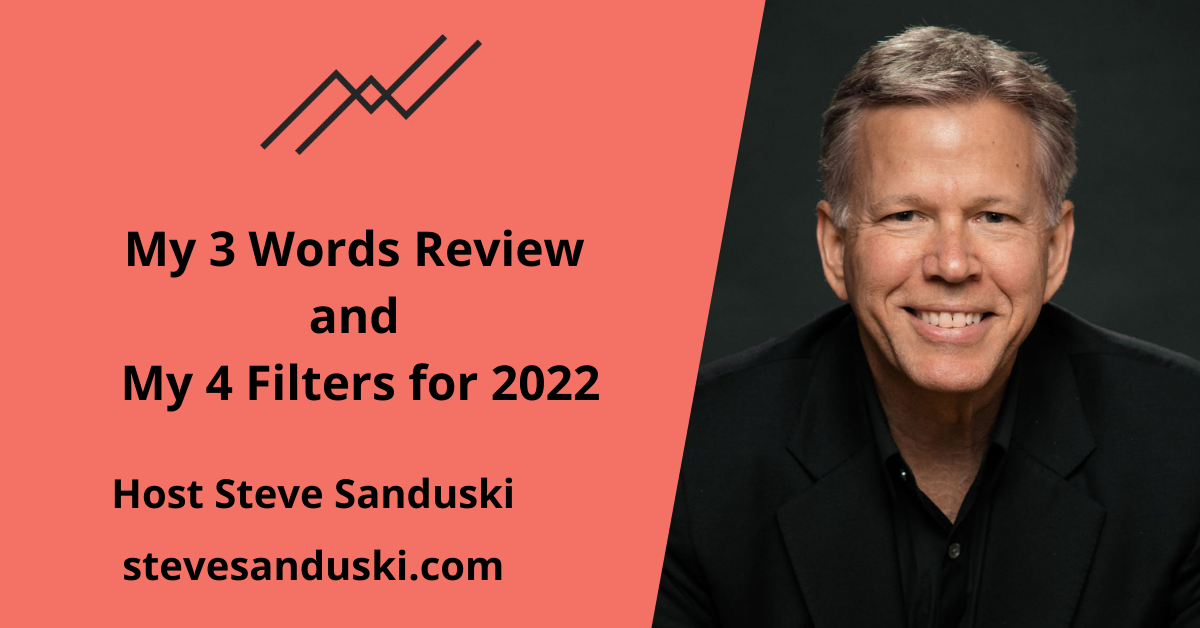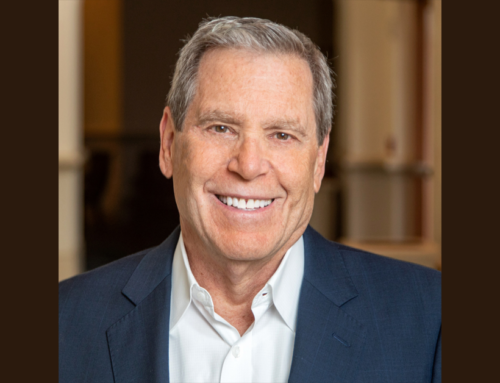For seven years, I’ve started each year with 3 words that I’ve carefully chosen to motivate me, remind me, and guide me on my road to making the New Year my best year ever.
My 3 words are printed at the top of my Daily Outcomes sheet (my prioritized to-do list) so I see them multiple times a day.
By being thoughtful when I identify my 3 words and then reviewing them on a daily basis, I have a daily reminder of my key focus for the year and this will (ideally) help me stay on track and on plan.
In today’s post, I review my 3 words for 2021 and discuss how well I executed on them.
I’ll also share why I am NOT doing this exercise in 2022 and what I’m doing in its place.
Past 3 Words
Here are my 3 words from previous years.
2015: Implement, Energy, Relationships
2016: Launch, Leverage, Connect
2017: Discipline, Deliver, Score
2018: Spark, Community, Savor
2019: Practice, Voice, Test
2020: Pace, Process, Prioritize
2021: Long-Form, Core, Connections
Review of My 3 Words for 2021
Let’s take a look back at my 3 words for 2021 and see what grade I give myself in terms of how the words guided my actions in the past year.
Long-form
I’m fairly prolific when it comes to publishing content. Between my five podcasts, I publish about 8 – 10 episodes a month, some of which have detailed show notes. I write GTK, my email letter. And then there’s some miscellaneous content including webinars and videos thrown in for good measure. And while I often spend a lot of time doing research for the content, most of the content I publish is what I’d call short form.
In 2021, I wanted to spend more time turning my research into long-from written content instead of just 900 word posts, 280 character tweets, or podcast show notes.
You often hear that humans have the attention span of a goldfish so you have to keep your content short and to the point. And for certain content, that’s true. But in 2021, I wanted to publish more long-form content, more “must-read” material that while long, would be so compelling you’d take the time to read it.
My plan was to publish a handful of posts, probably in the 3,000 to 7,500 word range, on topics that resonate with me and will add to the “canon” of that topic area.
One goal with this long-form “cornerstone” content was to get more organic search visitors to my website. And more website visitors should lead to more GTK subscribers.
So, how did I do on publishing long-form content?
I totally flunked and give myself an “F” grade!
I wrote 0 long-form pieces in 2021. It’s not like I just forgot about it. I saw those words on my Daily Outcomes sheet every day.
My problem was I just never found a topic that captured my imagination and where I had a unique take that I felt would garner some interest.
So, in one sense, I’m bummed that I didn’t write any long-form content last year but I’m also proud that I wasn’t tempted to publish some shlock that was more noise than signal.
Core
As an entrepreneur who has an insatiable curiosity, I love learning and trying new things. But, like eating cookies and cream ice cream with hot fudge, too much of a good thing can be (despite what Mae West says) a bad thing.
This hit home when one of my kids said to me, “I don’t know what to say when someone asks me, ‘What does your dad do?’”
It’s clear that I’m not sufficiently focused on my “core” work and not effective enough in communicating what I do and for whom I do it.
In 2021, my plan was to try and sharpen my gaze and spend more time in the core areas that really animate me and drive my business forward.
I’d grade myself a solid “B” in this area in 2021.
I didn’t add any new products or new businesses to my offerings in 2021; instead, I just continued to go deeper into my existing ones. I did add two new podcasts, The Digital Money Advisor and Actionable Intelligence, but I consider them extensions of what I was already doing. Conversely, I didn’t cut anything from my list either so that didn’t free up any of my time.
Given my visibility and longevity in the industry, there’s no shortage of opportunities and one-off things I could get involved in, and 2021 was no exception. I was able to avoid the temptation and stick to my “core” so I feel pretty good about that.
Connections
One of my favorite strategies for writing, coaching, and running businesses is to take disparate ideas and find the threads that connect them.
The wall in my office has a neon sign that says, “Everything is Connected.” My wife had it custom made and it’s a beauty with deep meaning.
In 2021, I wanted to go even deeper into finding the connections among people, business, and the natural world.
From a business standpoint, I wanted to explore connections in two particular areas. First, I wanted to continue “making connections” in my writing and speaking by telling better stories, analogies, and metaphors.
And second, I’m really into this idea of “systems thinking” and I wanted to be more cognizant of seeing “wholes” instead of discrete “things,” of recognizing “patterns” instead of just static “snapshots.” By “thinking in systems,” the world will make more sense.
Overall, I’d grade myself an “A” in this area in 2021.
Two things in particular standout here.
First, I started hosting Actionable Intelligence on The Barron’s Advisor Way Forward podcast. In this show, I interview people outside of the financial industry and then connect their learnings with how financial advisors can adapt them in their business. It’s been a huge success and I just started Season 2.
Second, I went much deeper in the area of systems thinking. One of the highlights here was the four days of training I did with Robert Fritz. I learned The Fundamentals of Structural Thinking and it has wide applicability in my life.
Something New for 2022
To mix things up and make sure I don’t get into a rut, I’ve decided to do something different in 2022 in place of the My 3 Words exercise. I’m calling it My 4 Filters. Here’s how it works.
All of us are bombarded with ideas, opportunities, and things that we can do or add to our life. But how do we go about systematically determining what we want to say yes to and what we say no to? And when we say yes, how do we ensure that we do or add that thing to our life in the most effective way?
The idea here is to come up with 3 or 4 filters that you run your important opportunities through to determine if it’s something you should do, and if so, how can you maximize its potential for success.
Here’s an example.
I’m at the point in my career where I just want to focus on the things that excite me, that make me go to bed at night looking forward to getting up in the morning.
And as I mentioned earlier, I have no shortage of opportunities. So, I started to ask myself, “What criteria should I use to determine what work I will do or how I will allocate my time?”
As I reflected on that question, I realized there are three key criteria that all my work has to incorporate. And they are:
- Deep Learning: I love to learn and want to keep growing in my knowledge of areas that fascinate me.
- Content Creation: I love creating, communicating, and publishing content in a wide variety of media including written, video, and audio.
- Flexibility: It’s critical that I have complete control of my schedule in terms of when and where I work.
Once I had those three criteria in place, I started using it as a filter for some of the most recent ideas that presented themselves to me. And what I realized was, there are a lot of things that meet those three filters, but I still wanted to say no to them.
I then realized that I needed to add a fourth filter.
- Look forward to: I must get excited when I see it on my calendar.
Now the filters made sense. I could run all my business opportunities through these four filters and it would simplify my decision-making process and ensure that I only work on things that excite me.
Now, let me share two nuances to this filtering system.
First, these filters differ from My 3 Words. With filters, you use them to determine what you do and how you can do it better. Whereas the My 3 Words is more about you’ve already decided what you want to do/focus on and the words are simply a reminder.
Second, I’ve structured my filters as a way to filter what I want to work on. You can structure your filters like that, or, you can design them as a way to help you optimize your business and/or life. For example, one of your filters might be “scalable.” And you could ask yourself, “Is this idea scalable or how can I structure this idea so it is more scalable?”
In other words, these filters are like screens that you run your ideas and opportunities through to see if they meet the criteria that you’ve identified in advance are important for you to meet.
A little earlier I talked about systems thinking with Robert Fritz. This filters idea is a perfect example of systems thinking. You’re creating a structure that defines the path of least resistance to achieve what it is you want to achieve.
Final Thought
Now it’s your turn. Develop your filtering system for 2022. I’d love to hear what yours is so tweet it to me @stevesanduski.
2021 was another difficult year for many people. And as we enter 2022, we still have our challenges. But I believe there is a bright light on that horizon and as long as we set our sights on it, while doing the things we need to do today, day in and day out, we will realize that bright light.
Let’s make 2022 a great year!





